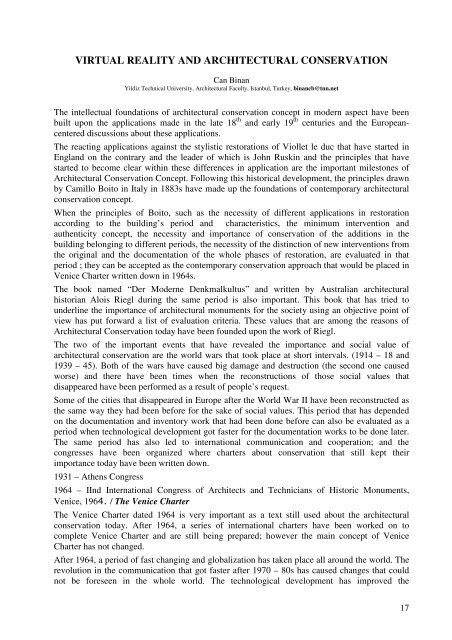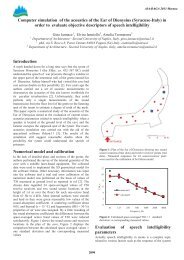ERATO Proceedings Istanbul 2006.pdf - Odeon
ERATO Proceedings Istanbul 2006.pdf - Odeon
ERATO Proceedings Istanbul 2006.pdf - Odeon
Create successful ePaper yourself
Turn your PDF publications into a flip-book with our unique Google optimized e-Paper software.
VIRTUAL REALITY AND ARCHITECTURAL CONSERVATION<br />
Can Binan<br />
Yildiz Technical University, Architectural Faculty, <strong>Istanbul</strong>, Turkey, binancb@tnn.net<br />
The intellectual foundations of architectural conservation concept in modern aspect have been<br />
built upon the applications made in the late 18 th and early 19 th centuries and the Europeancentered<br />
discussions about these applications.<br />
The reacting applications against the stylistic restorations of Viollet le duc that have started in<br />
England on the contrary and the leader of which is John Ruskin and the principles that have<br />
started to become clear within these differences in application are the important milestones of<br />
Architectural Conservation Concept. Following this historical development, the principles drawn<br />
by Camillo Boito in Italy in 1883s have made up the foundations of contemporary architectural<br />
conservation concept.<br />
When the principles of Boito, such as the necessity of different applications in restoration<br />
according to the building’s period and characteristics, the minimum intervention and<br />
authenticity concept, the necessity and importance of conservation of the additions in the<br />
building belonging to different periods, the necessity of the distinction of new interventions from<br />
the original and the documentation of the whole phases of restoration, are evaluated in that<br />
period ; they can be accepted as the contemporary conservation approach that would be placed in<br />
Venice Charter written down in 1964s.<br />
The book named “Der Moderne Denkmalkultus” and written by Australian architectural<br />
historian Alois Riegl during the same period is also important. This book that has tried to<br />
underline the importance of architectural monuments for the society using an objective point of<br />
view has put forward a list of evaluation criteria. These values that are among the reasons of<br />
Architectural Conservation today have been founded upon the work of Riegl.<br />
The two of the important events that have revealed the importance and social value of<br />
architectural conservation are the world wars that took place at short intervals. (1914 – 18 and<br />
1939 – 45). Both of the wars have caused big damage and destruction (the second one caused<br />
worse) and there have been times when the reconstructions of those social values that<br />
disappeared have been performed as a result of people’s request.<br />
Some of the cities that disappeared in Europe after the World War II have been reconstructed as<br />
the same way they had been before for the sake of social values. This period that has depended<br />
on the documentation and inventory work that had been done before can also be evaluated as a<br />
period when technological development got faster for the documentation works to be done later.<br />
The same period has also led to international communication and cooperation; and the<br />
congresses have been organized where charters about conservation that still kept their<br />
importance today have been written down.<br />
1931 – Athens Congress<br />
1964 – IInd International Congress of Architects and Technicians of Historic Monuments,<br />
Venice, 1964. / The Venice Charter<br />
The Venice Charter dated 1964 is very important as a text still used about the architectural<br />
conservation today. After 1964, a series of international charters have been worked on to<br />
complete Venice Charter and are still being prepared; however the main concept of Venice<br />
Charter has not changed.<br />
After 1964, a period of fast changing and globalization has taken place all around the world. The<br />
revolution in the communication that got faster after 1970 – 80s has caused changes that could<br />
not be foreseen in the whole world. The technological development has improved the<br />
17
















